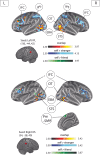Self-Awareness from Whole-Body Movements
- PMID: 39496486
- PMCID: PMC11735670
- DOI: 10.1523/JNEUROSCI.0478-24.2024
Self-Awareness from Whole-Body Movements
Abstract
Humans can recognize their whole-body movements even when displayed as dynamic dot patterns. The sparse depiction of whole-body movements, coupled with a lack of visual experience watching ourselves in the world, has long implicated nonvisual mechanisms to self-action recognition. Using general linear modeling and multivariate analyses on human brain imaging data from male and female participants, we aimed to identify the neural systems for this ability. First, we found that cortical areas linked to motor processes, including frontoparietal and primary somatomotor cortices, exhibit greater engagement and functional connectivity when recognizing self-generated versus other-generated actions. Next, we show that these regions encode self-identity based on motor familiarity, even after regressing out idiosyncratic visual cues using multiple regression representational similarity analysis. Last, we found the reverse pattern for unfamiliar individuals: encoding localized to occipitotemporal visual regions. These findings suggest that self-awareness from actions emerges from the interplay of motor and visual processes.
Keywords: actions; motor; neuroimaging; self-awareness.
Copyright © 2024 the authors.
Conflict of interest statement
The authors declare no competing financial interests.
Figures









Similar articles
-
Short-Term Memory Impairment.2024 Jun 8. In: StatPearls [Internet]. Treasure Island (FL): StatPearls Publishing; 2025 Jan–. 2024 Jun 8. In: StatPearls [Internet]. Treasure Island (FL): StatPearls Publishing; 2025 Jan–. PMID: 31424720 Free Books & Documents.
-
A New Measure of Quantified Social Health Is Associated With Levels of Discomfort, Capability, and Mental and General Health Among Patients Seeking Musculoskeletal Specialty Care.Clin Orthop Relat Res. 2025 Apr 1;483(4):647-663. doi: 10.1097/CORR.0000000000003394. Epub 2025 Feb 5. Clin Orthop Relat Res. 2025. PMID: 39915110
-
Personalised care planning for adults with chronic or long-term health conditions.Cochrane Database Syst Rev. 2015 Mar 3;2015(3):CD010523. doi: 10.1002/14651858.CD010523.pub2. Cochrane Database Syst Rev. 2015. PMID: 25733495 Free PMC article.
-
Transition of care for adolescents from paediatric services to adult health services.Cochrane Database Syst Rev. 2016 Apr 29;4(4):CD009794. doi: 10.1002/14651858.CD009794.pub2. Cochrane Database Syst Rev. 2016. PMID: 27128768 Free PMC article.
-
How lived experiences of illness trajectories, burdens of treatment, and social inequalities shape service user and caregiver participation in health and social care: a theory-informed qualitative evidence synthesis.Health Soc Care Deliv Res. 2025 Jun;13(24):1-120. doi: 10.3310/HGTQ8159. Health Soc Care Deliv Res. 2025. PMID: 40548558
References
-
- Arbib MA (1981) Perceptual structures and distributed motor control. In: Handbook of physiology, section I: the nervous system, vol. 2: motor control (Brooks VB, ed.), pp 1449–1480. Baltimore: Williams and Wilkins.
-
- Arbib MA (1992) Schema theory. In: The encyclopedia of artificial intelligence, Vol. 2, pp 1427–1443. New York, NY: Wiley Interscience.
MeSH terms
LinkOut - more resources
Full Text Sources
